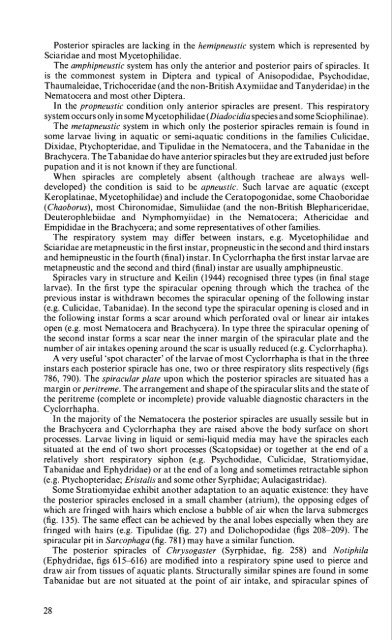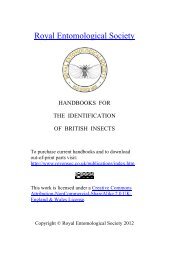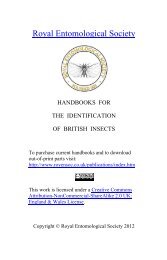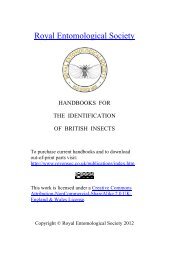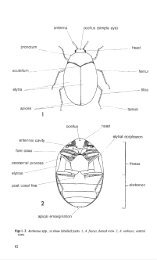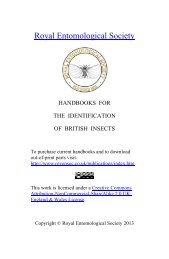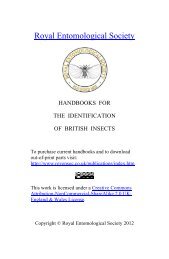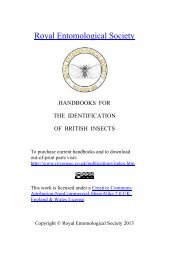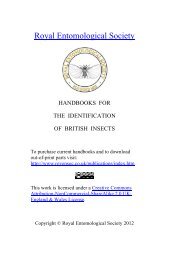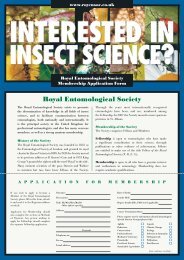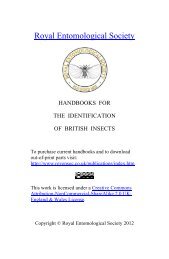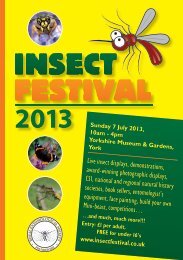Vol 10 Part 14. An introduction to the immature stages of British Flies ...
Vol 10 Part 14. An introduction to the immature stages of British Flies ...
Vol 10 Part 14. An introduction to the immature stages of British Flies ...
You also want an ePaper? Increase the reach of your titles
YUMPU automatically turns print PDFs into web optimized ePapers that Google loves.
Posterior spiracles are lacking in <strong>the</strong> hemipneustic system which is represented by<br />
Sciaridae and most Myce<strong>to</strong>philidae.<br />
The amphipneustic system has only <strong>the</strong> anterior and posterior pairs <strong>of</strong> spiracles. It<br />
is <strong>the</strong> commonest system in Diptera and typical <strong>of</strong> <strong>An</strong>isopodidae, Psychodidae,<br />
Thaumaleidae, Trichoceridae (and <strong>the</strong> non-<strong>British</strong> Axymiidae and Tanyderidae) in <strong>the</strong><br />
Nema<strong>to</strong>cera and most o<strong>the</strong>r Diptera.<br />
In <strong>the</strong> propneustic condition only anterior spiracles are present. This respira<strong>to</strong>ry<br />
system occurs only in some Myce<strong>to</strong>philidae (Diadocidia species and some Sciophilinae).<br />
The metapneustic system in which only <strong>the</strong> posterior spiracles remain is found in<br />
some larvae living in aquatic or semi-aquatic conditions in <strong>the</strong> families Culicidae,<br />
Dixidae, Ptychopteridae, and Tipulidae in <strong>the</strong> Nema<strong>to</strong>cera, and <strong>the</strong> Tabanidae in <strong>the</strong><br />
Brachycera. The Tabanidae do have anterior spiracles but <strong>the</strong>y are extruded just before<br />
pupation and it is not known if <strong>the</strong>y are functional.<br />
When spiracles are completely absent (although tracheae are always welldeveloped)<br />
<strong>the</strong> condition is said <strong>to</strong> be apneustic. Such larvae are aquatic (except<br />
Keroplatinae, Myce<strong>to</strong>philidae) and include <strong>the</strong> Cera<strong>to</strong>pogonidae, some Chaoboridae<br />
(Chaoborus}, most Chironomidae, Simuliidae (and <strong>the</strong> non-<strong>British</strong> Blephariceridae,<br />
Deuterophlebiidae and Nymphomyiidae) in <strong>the</strong> Nema<strong>to</strong>cera; A<strong>the</strong>ricidae and<br />
Empididae in <strong>the</strong> Brachycera; and some representatives <strong>of</strong> o<strong>the</strong>r families.<br />
The respira<strong>to</strong>ry system may differ between instars, e.g. Myce<strong>to</strong>philidae and<br />
Sciaridae are metapneustic in <strong>the</strong> first ins tar, propneustic in <strong>the</strong> second and third ins tars<br />
and hemipneustic in <strong>the</strong> fourth (final) ins tar. In Cyclorrhapha <strong>the</strong> first ins tar larvae are<br />
metapneustic and <strong>the</strong> second and third (final) instar are usually amphipneustic.<br />
Spiracles vary in structure and Keilin (1944) recognised three types (in final stage<br />
larvae). In <strong>the</strong> first type <strong>the</strong> spiracular opening through which <strong>the</strong> trachea <strong>of</strong> <strong>the</strong><br />
previous instar is withdrawn becomes <strong>the</strong> spiracular opening <strong>of</strong> <strong>the</strong> following instar<br />
(e.g. Culicidae, Tabanidae). In <strong>the</strong> second type <strong>the</strong> spiracular opening is closed and in<br />
<strong>the</strong> following instar forms a scar around which perforated oval or linear air intakes<br />
open (e.g. most Nema<strong>to</strong>cera and Brachycera). In type three <strong>the</strong> spiracular opening <strong>of</strong><br />
<strong>the</strong> second instar forms a scar near <strong>the</strong> inner margin <strong>of</strong> <strong>the</strong> spiracular plate and <strong>the</strong><br />
number <strong>of</strong> air intakes opening around <strong>the</strong> scar is usually reduced (e.g. Cyclorrhapha).<br />
A very useful 'spot character' <strong>of</strong> <strong>the</strong> larvae <strong>of</strong> most Cyclorrhapha is that in <strong>the</strong> three<br />
instars each posterior spiracle has one, two or three respira<strong>to</strong>ry slits respectively (figs<br />
786, 790). The spiracular plate upon which <strong>the</strong> posterior spiracles are situated has a<br />
margin or peritreme. The arrangement and shape <strong>of</strong> <strong>the</strong> spiracular slits and <strong>the</strong> state <strong>of</strong><br />
<strong>the</strong> peritreme (complete or incomplete) provide valuable diagnostic characters in <strong>the</strong><br />
Cyclorrhapha.<br />
In <strong>the</strong> majority <strong>of</strong> <strong>the</strong> Nema<strong>to</strong>cera <strong>the</strong> posterior spiracles are usually sessile but in<br />
<strong>the</strong> Brachycera and Cyclorrhapha <strong>the</strong>y are raised above <strong>the</strong> body surface on short<br />
processes. Larvae living in liquid or semi-liquid media may have <strong>the</strong> spiracles each<br />
situated at <strong>the</strong> end <strong>of</strong> two short processes (Sca<strong>to</strong>psidae) or <strong>to</strong>ge<strong>the</strong>r at <strong>the</strong> end <strong>of</strong> a<br />
relatively short respira<strong>to</strong>ry siphon (e.g. Psychodidae, Culicidae, Stratiomyidae,<br />
Tabanidae and Ephydridae) or at <strong>the</strong> end <strong>of</strong> a long and sometimes retractable siphon<br />
(e.g. Ptychopteridae; Eristalis and some o<strong>the</strong>r Syrphidae; Aulacigastridae).<br />
Some Stratiomyidae exhibit ano<strong>the</strong>r adaptation <strong>to</strong> an aquatic existence: <strong>the</strong>y have<br />
<strong>the</strong> posterior spiracles enclosed in a small chamber (atrium}, <strong>the</strong> opposing edges <strong>of</strong><br />
which are fringed with hairs which enclose a bubble <strong>of</strong> air when <strong>the</strong> larva submerges<br />
(fig. 135). The same effect can be achieved by <strong>the</strong> anal lobes especially when <strong>the</strong>y are<br />
fringed with hairs (e.g. Tipulidae (fig. 27) and Dolichopodidae (figs 208- 209). The<br />
spiracular pit in Sarcophaga (fig. 781) may have a similar function.<br />
The posterior spiracles <strong>of</strong> Chrysogaster (Syrphidae, fig . 258) and Notiphila<br />
(Ephydridae, figs 615-616) are modified in<strong>to</strong> a respira<strong>to</strong>ry spine used <strong>to</strong> pierce and<br />
draw air from tissues <strong>of</strong> aquatic plants. Structurally similar spines are found in some<br />
Tabanidae but are not situated at <strong>the</strong> point <strong>of</strong> air intake, and spiracular spines <strong>of</strong><br />
28


